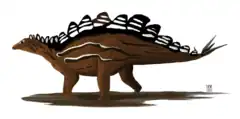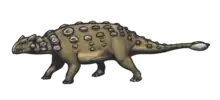| Priconodon Temporal range: Early Cretaceous, | |
|---|---|
| Priconodon tooth in multiple views | |
| Scientific classification | |
| Domain: | Eukaryota |
| Kingdom: | Animalia |
| Phylum: | Chordata |
| Clade: | Dinosauria |
| Clade: | †Ornithischia |
| Clade: | †Thyreophora |
| Suborder: | †Ankylosauria |
| Family: | †Nodosauridae |
| Genus: | †Priconodon |
| Species: | †P. crassus |
| Binomial name | |
| †Priconodon crassus Marsh, 1888 | |
Priconodon (meaning "saw cone tooth"[1]) is an extinct genus of dinosaur (perhaps nodosaurid), known from its large teeth. Its remains have been found in the Aptian-Albian age Lower Cretaceous Arundel Formation of Muirkirk, Prince George's County, Maryland, USA and the Potomac Group, also located in Maryland.
History
O. C. Marsh named the genus for USNM 2135, a large worn tooth from what was then called the Potomac Formation. As ankylosaurians were by and large unknown at the time, he compared it to Diracodon (=Stegosaurus) teeth.[2] It was not identified as an ankylosaurian until Walter Coombs assigned it to Nodosauridae in 1978.[3]
In 1998 Kenneth Carpenter and James Kirkland, in a review of North American Lower Cretaceous ankylosaurs, considered it tentatively valid as an unusually large nodosaurid, larger than all those described before.[4] Carpenter (2001) retained it as a valid nodosaurid, but did not employ it in his phylogenetic analysis.[5] Vickaryous et al. (2004), in a review of armored dinosaurs, considered it to be dubious without comment.[6] West and Tibert, however, followed this with a preliminary account of a morphometric study that found it to be a unique genus.[7]
Material
Carpenter and Kirkland (1998) listed 12 additional teeth from the same area as the holotype tooth, and tentatively added a robust tibia (USNM 9154) to the genus. They found the lack of armor found in the Arundel to be peculiar, but noted that fossils are rare in that formation anyway.[4]
Paleobiology
As a nodosaurid, Priconodon would have been a slow, armored, quadrupedal herbivore.[6] It would have been a large nodosaurid, but since only teeth are definitely known for the genus, size estimation has not been done.
See also
References
- ↑ "Untitled Document".
- ↑ Marsh, O.C. (1888). Notice of a new genus of Sauropoda and other new dinosaurs from the Potomac Formation. American Journal of Science 135:89-94.
- ↑ Coombs, Jr., W.P. (1978). The families of the ornithischian dinosaur order Ankylosauria. Palaeontology 21(1):143-170.
- 1 2 Carpenter, K., and Kirkland, J.I. (1998). Review of Lower and middle Cretaceous ankylosaurs from North America. In: Lucas, S.G., Kirkland, J.I., and Estep, J.W. (eds.). Lower and Middle Cretaceous Terrestrial Ecosystems. New Mexico Museum of Natural History and Science Bulletin 14:249-270.
- ↑ Carpenter, K. (2001). Phylogenetic analysis of the Ankylosauria. In: Carpenter, K. (ed.). The Armored Dinosaurs. Indiana University Press:Bloomington 455-483. ISBN 0-253-33964-2
- 1 2 Vickaryous, M.K., Maryańska, T., and Weishampel, D.B., (2004). Ankylosauria. In: Weishampel, D.B., Dodson, P., and Osmólska, H. (eds.). The Dinosauria (second edition). University of California Press:Berkeley 363-392. ISBN 0-520-24209-2
- ↑ "West, A. and Tibert, N. (2004). Quantitative analysis for the type material of Priconodon crassus: a distinct taxon from the Arundel Formation in souther Maryland. Geological Society of America Abstracts with Programs, 36(5):423". Archived from the original on 2007-01-06. Retrieved 2007-01-05.

